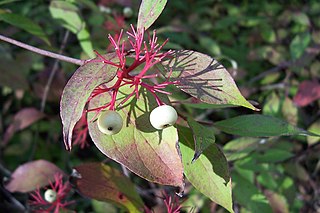Dogwood (Cornus)
On this page... (hide)
- 1. Uses
- 1.1 Wood
- 1.2 Red Osier (Cornus sericea)
- 1.3 Growth
- 2. Uses
- 2.1 Green Osier (Cornus alternifolia)
- 2.2 Growth
- 2.3 Uses
- 3. More
- 4. 'Souls
| Common Name | Dogwood |
| Latin Name | Cornus (genus) |
| Icon(s) |   
|
|
"Red Osier Dogwood" | |
'Souls has two types of dogwood, a shrub and a tree. They are dissimilar enough to be unmistakable for one another and are not known to hybridize. Both are deciduous and bear berry-like fruit.
1. Uses
- Tannin: Their bark is rich in tannin and has been used as a substitute for quinine.
- Hygeine: Dogwood twigs were used by pioneers to brush their teeth. They would peel off the bark, bite the twig and then scrub their teeth.
- Folklore: The term "dogwood winter" is sometimes used to describe a cold snap in spring, presumably because farmers believed it was not safe to plant their crops until after the dogwoods blossomed.
1.1 Wood
Dense and fine-grained, dogwood timber has a high density. Though tough for woodworking, some artisans prized dogwood for its grain and hardness. It was used for making looms, tool handles, walking canes, longbows, fine inlays, and other small projects that require a very hard and strong wood.
1.2 Red Osier (Cornus sericea)
It is a medium to tall shrub, growing 1.5–4 m tall and 3–5 m wide, forming dense thickets. The branches and twigs are dark red, although they may lack this coloration in shaded areas. The leaves are opposite, with an oblong shape and dark green upper color, glaucous below. Fall color is commonly bright red to purple. The flowers are small (5–10 mm diameter), dull white, in clusters 3–6 cm diameter. The fruit is a globose white berry 5–9 mm diameter.
1.3 Growth
Common. Nova Scotian native. In the wild, it commonly grows in areas of damp soil, such as wetlands. It is not found south of Halifax or east of The Waste.
2. Uses
- Medicinal: Berries were sometimes eaten to treat colds and slow bleeding.
- The inner bark was used as "traditional tobacco", either by itself or in a mixture with other plant materials (kinnikinnick)., The inner bark was blended with tobacco, sometimes with Bearberry leaf.
- Dye: The Ojibwe used red osier dogwood bark as a dye by taking the inner bark, mixing it with other plants or minerals.
2.1 Green Osier (Cornus alternifolia)
This small tree growing to 25 feet (8 m) high. Dark reddish brown bark with leaves green above and very pale green below. The flowers are pale white-cream; the fruit is dark purple and of intensely disagreeable aroma.
2.2 Growth
Common. This Nova Scotian native is found throughout all 'Souls territories. It is found under taller trees in moist deciduous forests, preferring the margins of forests and swamps with well drained soil.
2.3 Uses
- Dye: "The roots, mixed with vinegar, yield a light to dark brown dye." [1]
Medicinal
"Cornus alternifolia was employed medicinally by a number of native North American Indian tribes, though it was little used" in modern human herbalism." [2] Luperci may consider it still effective:
- "Green osier was employed medicinally by a number of native North American Indian tribes who valued it particularly for its astringent bark which was used both internally and externally to treat diarrhoea, skin problems etc. It is little used in modern herbalism. The dried bark is used as an astringent, diaphoretic and stimulant. The inner bark was boiled and the solution used as an enema and this solution was also used as a tea to reduce fevers, treat influenza, diarrhoea, headaches, voice loss etc. It was used as a wash for the eyes. A compound infusion of the bark and roots has been used to treat childhood diseases such as measles and worms. It has also been used as a wash on areas of the body affected by venereal disease. A poultice of the powdered bark has been used to treat swellings, blisters etc." [3]
3. More
4. 'Souls
- Hey, did your character do something cool with this plant?
- Or maybe your pack has it for trade?

